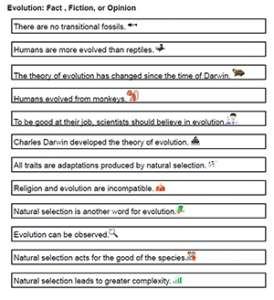
This lesson can be used to introduce evolution and establish what your students already understand (or misunderstand) about evolutionary theory.
Statements can be printed and cut into slips and students work in small groups to categorize each statement as either Fact, Fiction, or Opinion.
The included answer key has quick explanations as well as links to authoritative sources to explain the positions, sources from Berkeley’ Understanding Evolution and New Scientist.
Evolution misconceptions are fairly common for beginning biology students. For example, many think that evolution leads to greater complexity, or that natural selection is the only process that results in evolution.
What your students know depends greatly on how much was covered (or not covered) in previous classes.
A google doc link is included for editing or adding new statements.
The exercise also serves as a starting point for discussions about what facts, models, and theories are within the context of science.
HS-LS4-1 Communicate scientific information that common ancestry and biological evolution are supported by multiple lines of empirical evidence

